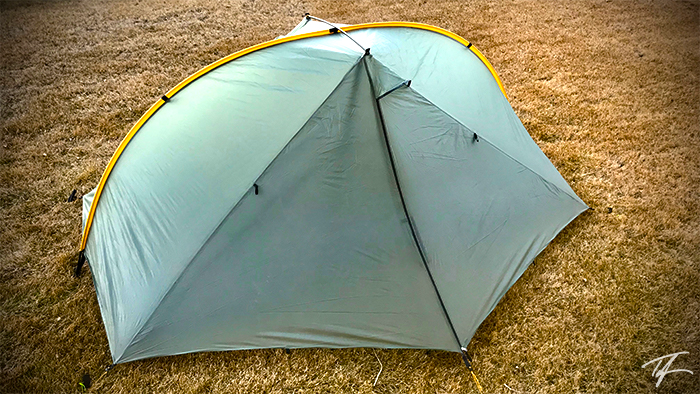Tarptent Double Rainbow Tent
I purchased a secondhand 2019 version Tarptent Double Rainbow two person backpacking tent in February 2020. The tent had about eight nights of use and the seller didn't provide the stakes that Tarptent includes with their tents. It was needed for a week-long Uinta Highline Trail thru-hike in mid-Summer 2020 where most of the trail is above the treeline and I wouldn't be able to reliably hammock for most of the hike. I've needed to invest in a reliable ground shelter for those times—especially since I live so close to the desert canyons of Utah too. This was the final piece I needed to go-to-ground. My ground sleep system (quilt, pad, and shelter) weighs about eight ounces more than my hammock sleep system (quilts, hammock, shelter).
For quite awhile I researched and debated on several tents in the under three pound range and was very close to purchasing a Big Agnes Fly Creek HV UL2 but decided that one of my important requirements was that I wanted a tent with side entry and not on the narrower long end. I seriously considered a Big Agnes Tiger Wall UL2 as well but ultimately decided on the Tarptent Double Rainbow because of it's similar size and weight but used standard and easily replaceable tent poles. I also wanted a tent with ample space for one but sufficient for two if desired—albeit very cozy.
I also considered tents that use only trekking poles for setup but I am not certain I will always want to use trekking poles. Also, I often camp in the same site for multiple nights with day hikes to nearby areas and don't want to either leave my trekking poles on my tent or drop my tent so I can use them on the day hikes.
This single-wall tent isn't freestanding by default but can be with use of a trekking pole at each end. The Tarptent Double Rainbow has interior dimensions of 42" high, 52" wide at both ends, and 88" long. Including both vestibules, 24" each. In total, the tent is 100" wide.
The disadvantage of single-wall tents is that they are more prone to condensation issues as there isn't an inner wall of material to keep occupants from contact with the outer wall where condensation forms. Weather, site selection, and ventilation are key factors in controlling condensation. It is best to avoid situations that cause water vapor to form from body heat and breath, nearby water sources, low lying areas, or extreme cold or high humidity.
Initial impressions
- The tent seems very well constructed and thought out. It's a very nice design.
- Dimensions and weights seem to be as advertised.
- It's not difficult to setup, but I didn't come even close to their "two-minute" setup time.
- Make sure you secure the top strut crossbar before the arch pole as I found it very difficult to do after.
- The grosgrain and buckles on each end of the arched pole don't seem to hold very well. The grosgrain slips and doesn't hold.
- For the price, this tent is a very good choice for a sub-three pound "two person" tent.
Non-permanent modifications
- The seller didn't provide the original tent stakes, so I purchased set of eight titanium nail stakes from Amazon. They are similar to the DutchWare version, but about two inches (50mm) longer. The tent only requires six for setup, but I wanted eight so I could use them with additional removable guylines in the event of high winds.
- I replaced the guylines with 2mm Z-Line. The bright yellow cord isn't reflective, but easily stands out both during the day and at night.
- To protect the bottom of the tent, I made a footprint with 1.1 oz silpoly in Blaze Orange from RipstopByTheRoll. It can double as a signal flag if one is ever needed.
- Since I'd rather place the tent inside my backpack horizontally and carry the poles vertically on the outside of my pack, I sewed two new stuff sacks using some silnylon I had left over from previous project.

